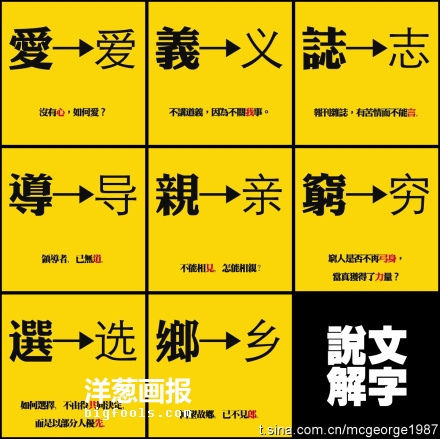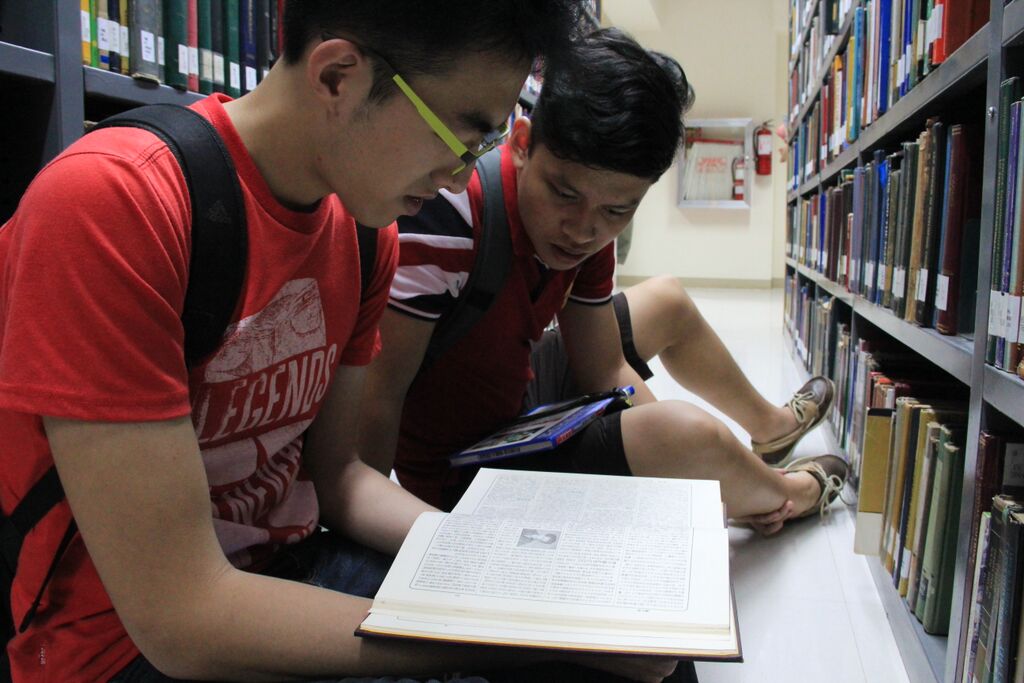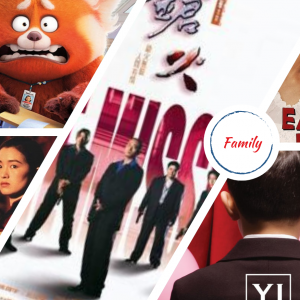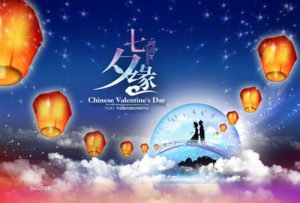Traditional Chinese or simplified Chinese? The question dawns on most teachers teaching the language or on students learning it. In today’s day and age, traditional text evokes a sense of culture and tradition, while simplified text gives a sense of adaptation to the changes of time. Both, however, have been the topic of debates for years as to which is the better writing system to use.
The History of the Chinese Language
The Chinese writing system today is deeply rooted in the past and began as pictograms. Early writings have been found in the oracle bone script as early as the Shang Dynasty in 1600–1050 BCE with the script etched on animal and human bones, then used to make predictions of the future (Brown & Lai, 2006). Over time, the pictograms evolved to the complex traditional characters whose lines and strokes combined convey the definition of the word.

A picture depicting the meaning lost when characters are simplified. (Image courtesy of sina.com)
Proponents of traditional Chinese characters argue that by simplifying characters, some of the original meaning is lost. For example, the first word indicated above is the character for “love,” 愛. In the traditional writing, it contained the character for “heart,” 心, in the center, implying that love comes from within the heart. In the simplified version, however, 心 was reduced and the entire character became, 爱. The lack of 心 in the middle arguably resulted to the character’s loss of deeper meaning that it once had. The change has alienated some people of the older generation, whom are accustomed to this writing, because of this perceived loss of meaning and history in the words themselves.

The evolution of the Chinese text: from oracle bone script to the standard traditional text. The character for tree over the years. (Image courtesy of priceonomics.com)
Those in favor of the simplified text, however, point out that the characters have already undergone several changes to reach its current state—from the early pictograms to the Bronze script and to the standard traditional text. Times change and so does language need to adapt to the life today. The simplified characters have not lost the meaning in the process of simplification; the lexical definition associated with the characters have been preserved. Moreover, simplified text is easier to read in signage and official documents as it is difficult to see some of the fine details in traditional characters in forms where small font sizes are used and also if one is looking at signage from a distance.

Newspaper article written in traditional text. Some people argue that traditional text can be difficult to read especially in cases where small font sizes are used. (Original image from EthanChung.com)
The Effects on the Literacy Rate
Another argument for which writing style is better is through the literacy rate. During the Kuomintang period, where traditional characters were employed, the literacy rate was only 15 to 25% (Schugurensky, n.d.). When the Communist Party took over in 1949, they aimed to increase mainland China’s literacy rate by implementing simplified characters. The literacy rate since then improved significantly with the simpler characters, as it is considered the easier written form to learn. By 1990, the rate has impressively increased to 78% and in 2010, it became 95% (The Globalist, 2014). The rise could be a result of the shift of focus to education and simplification as a means of attaining it, despite some of the traditional words do not have its simplified counterpart.
Traditional text, on the other hand, is often found more difficult to learn due to its complexity. For example, the word “school” in traditional text is written as 學 with 15 strokes whereas the simplified version allows it to be written in 8 strokes, 学. But if simplification is the basis of a good literacy rate, then the literacy rates in Taiwan and Hong Kong, both of which mainly use traditional text, can prove otherwise. Taiwan, strictly using traditional text, garnered a literacy rate of 96.1%, higher than the PRC, while Hong Kong boasts a 93.5% literacy rate, quite high as well (Index Mundi, 2014). Either way, the literacy rate presented a good percentage so we cannot base which writing system should be used as both yield great results in terms of literacy.
Practicality on a Global Scale
The countries outside the Sinosphere began adopting simplified text in teaching Mandarin to lessen the complexities of traditional text. The problem in this is that foreigners will still need to learn traditional text if they visit Taiwan or Hong Kong.
Can these writing systems complement each other or does one have to take precedence over the other? It can be seen that each writing system is better used for certain cases. As most literary and historical works were written with traditional characters, mastery of traditional characters can help people better appreciate Chinese literature according to Chang Song Hing, a professor at the Chinese University of Hong Kong; traditional text may also serve as a foundation for learning simplified text. Simplified text can then be used for everyday situations since it is easier to read and write. In addition to this, they can be used in tandem with another, as tourist signs in regions such as Hong Kong can often be found having versions rendered in both traditional and simplified texts.

Signage from HSBC rendered in both traditional and simplified text. Such signs are often found in HK SAR. (Original image from WordPress.com)
According to an article published on the GB Times, several scholars in Hong Kong said that traditional and simplified text need not have an antagonistic relationship with each other, encouraging students to master both writing systems in order to better communicate with people from Chinese communities both inside and outside of mainland China.
As a professor of Chinese literary and cultural studies at Harvard University, Eileen Cheng-yin Chow, says, “Traditional characters and simplified characters never were two separate and autonomous language systems—they have always existed on a continuum.” She explains, “Many simplified characters are adaptations from common usage in Chinese cursive script; on the other hand, the inability to read traditional characters is to close oneself off to much of the Chinese cultural legacy—its history and arts—before the 1950s.” (The New York Times, 2009). She recounted her experience learning to compromise to both systems:
“Since I grew up in Taiwan, where reading and writing in traditional characters is the norm, simplified characters were a novelty and a bit of a challenge, and perhaps, something to be sniffed at. But when my first job after college led me to Beijing to work as a literary translator, I spent the first week furtively consulting a little manual of “Simplified/Traditional Character Conversion” before I became fully comfortable with the new system, including learning to write my name in a way that was comprehensible to desk clerks. The experience taught me the follies of being a cultural purist.” (The New York Times, 2009).
So which writing system is better? Though there are people who support only one type of writing system and are unnecessarily at odds with one another, it does not need to be. In fact, both writing systems are already used simultaneously for different purposes. Using the two writing systems in tandem, can help drive the evolution of the Chinese language as a whole in order to keep up with the times while still paying respect to tradition. As posted by one forum commentator in Hong Kong, “Both traditional and simplified Chinese belong to the Chinese language. It is good as long as everyone can understand.”
Written by Kendric Tee and Faith Ong
References
Brown, Waka Takahashi & Lai Selena. (2006). The Shang Dynasty, 1600 to 1050 BCE. Stanford SPICE. Retreived from http://spice.fsi.stanford.edu/docs/the_shang_dynasty_1600_to_1050_bce
Chung, E. (2009, March 21). [Newspaper article written in traditional text]. Retrieved from http://www.ethanchung.com/share/file_2009/2009-03-21-WJPhoto1.jpg
Cima, Rosie. (2015). How Autocomplete Was Built into Chinese Typewriters [Photograph]. Priceonomics. Retrieved from http://priceonomics.com/how-autocomplete-was-built-into-chinese/
Dictionary of Politically Incorrect Hong Kong Cantonese. (2013, February 6). [HSBC signage in traditional and simplified text]. Retrieved from https://badcanto.files.wordpress.com/2013/02/photogrid_1360399707543.jpg?w=700
Hong Kong Literacy. Index Mundi. Retrieved from http://www.indexmundi.com/hong_kong/literacy.html
Schugurensky, Daniel (Ed.). (N.d.). 1949: The Educational Revolution Begins in China. History of Education: Selected Moments of the 20th Century. OISE/UT. Retrieved from http://schugurensky.faculty.asu.edu/moments/1949china.html
Sina.com. (2014, April 25). A comparison between traditional Chinese characters and simplified ones. Sina.com. Retrieved from http://img.news.sina.com/culture/p/2014/0425/U211P5029T2D694986F26DT20140425174926.jpg
Taiwan Demographics Profile 2014. Index Mundi. Retrieved from http://www.indexmundi.com/taiwan/demographics_profile.html
The New York Times. (2009). The Chinese Language, Ever Evolving. The New York Times: Room for Debate. Retrieved from http://roomfordebate.blogs.nytimes.com/2009/05/02/chinese-language-ever-evolving/?_r=2
The Globalist. (2014). 11 Facts: China’s Improving Literacy Rate: Since 1990, China’s literacy rate has been rapidly improving. The Globalist. Retrieved from http://www.theglobalist.com/11-facts-chinas-improving-literacy-rate/
Written by Kendric Tee




